Lisbon by Tram

Trams are the ideal means to explore some of the most interesting spots of Lisbon’s historical and architectural heritage, or simply to tour the city.
The most widely known is Tram no. 28 that runs from Martim Moniz to Campo de Ourique. Although you can hop on at any point, the route starts in the historical centre, Largo Martim Moniz (square), heading to the Graça quarter and continuing to the Church of São Vicente de Fora. It then heads to Alfama, past some of mediaeval Lisbon’s most picturesque streets and squares, such as Rua das Escolas Gerais and Largo das Portas do Sol, a lovely viewpoint over the hillside down to the river. From here, you can walk to the São Jorge Castle in no time at all.
The route continues to the city centre, past the Cathedral, with its austere Romanesque façade, the Church of Santo António, and down the busy Rua da Conceição, a traditional shopping street known to the Lisbon people for its haberdasheries.
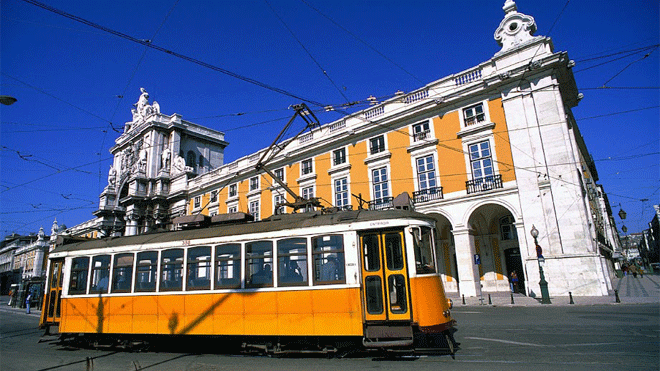
Photo: Praça do Comércio © João Paulo
The tram then heads to the elegant Chiado hill, almost certainly stopping outside the famous Pastry Shop A Brasileira. It’s worth noticing throughout the route the architecture of the buildings, and the tiles cladding some of the façades, at least in brief Art Nouveau friezes, usually close to the roofs.
Past Largo do Camões, just outside Bairro Alto, where you can dine later and have fun in the Lisbon night, the tram goes back down the cobbled street. Further ahead, the main highlight is the Parliament building, former Convent of São Bento, at the top of an imposing set of steps.
Past the Basilica and Estrela Garden, Tram 28 continues, crossing the traditional residential area of Campo de Ourique, in the direction of Largo dos Prazeres.
This is the end of the line, but the tram will reverse and you can retrace your route to the city centre. You will pass the same spots, but the perspective is different and you will always find new details and points of interest.
Yellow is the signature colour of the trams, and the 28 is the most well-known, mentioned in all the tourist guides. But there is a historical red version too, which is more comfortable and offers a guided tour to ensure you don’t miss any detail along the route.
Other trams, other routes
Tram No. 12 follows a circular route from Praça da Figueira, past Martim Moniz, and climbs to the Castelo quarter. From Largo das Portas do Sol, the route is identical to the 28’s, taking you back to the city centre.
You can also take Tram No. 15, from Praça da Figueira in the city centre, to Algés, which is usually a good way to get to Belém. Moreover, it travels alongside the river, which makes the tour all that more interesting. This is a more modern and faster tram.
From Cais do Sodré, Tram No. 18 will take you to Ajuda, the quarter in the upper part of Belém. It is one of the public transport options to get to the Ajuda National Palace, the last official residence of the Portuguese royal family, today converted into a museum.
From the Largo do Camões, in Chiado, the Tram No. 24 is a good option if you are going to Campolide, via Príncipe Real, Rato and Amoreiras.
Tram No. 25 links Praça da Figueira to the Campo de Ourique neighbourhood. On the way, it goes past the Santos and Lapa quarters and the Estrela Basilica. It’s an optional route for those who want to visit the National Museum of Ancient Art. If so, hop off at the “Santos” stop and walk for a few minutes.
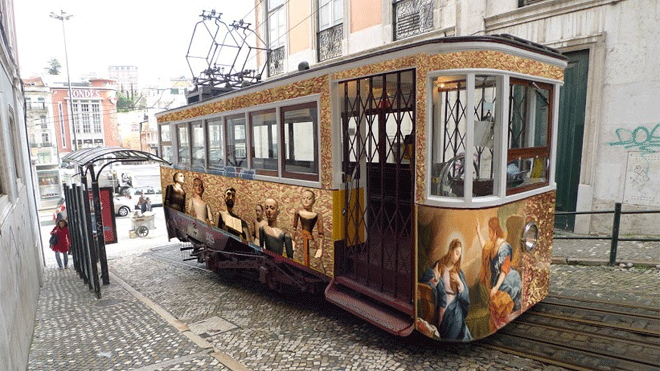
Photo: Elevador da Glória
There are also 3 lifts and a tram, considered National Monuments that help you climb the hills of the city. At Restauradores, you can take Elevador da Glória to get to Bairro Alto, Príncipe Real and the viewpoint of Jardim de São Pedro de Alcântara quicker. Across Avenida da Liberdade, halfway along the parallel Rua das Portas de Santo Antão, the Elevador do Lavra takes you up to Jardim do Torel. Close to Chiado, Elevador da Bica connects two old neighbourhoods that are a nightlife reference of Lisbon, Bairro Alto and Cais do Sodré.
One of Lisbon's attractions, in the heart of Baixa (downtown), is Elevador de Santa Justa, an excellent viewpoint over the city centre. A reference in architecture using iron in Portugal, constructed at the beginning of the 20th century (1902), by the Frenchman Raoul Mesnier du Ponsard, a disciple of Eiffel.
For more information on routes and fares, see www.carris.pt



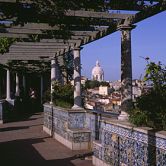
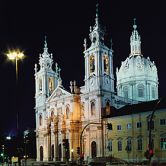

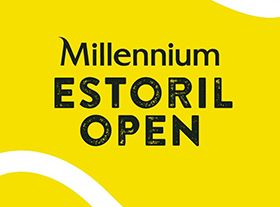
 Explore
Explore 
 Remember and Share
Remember and Share 


